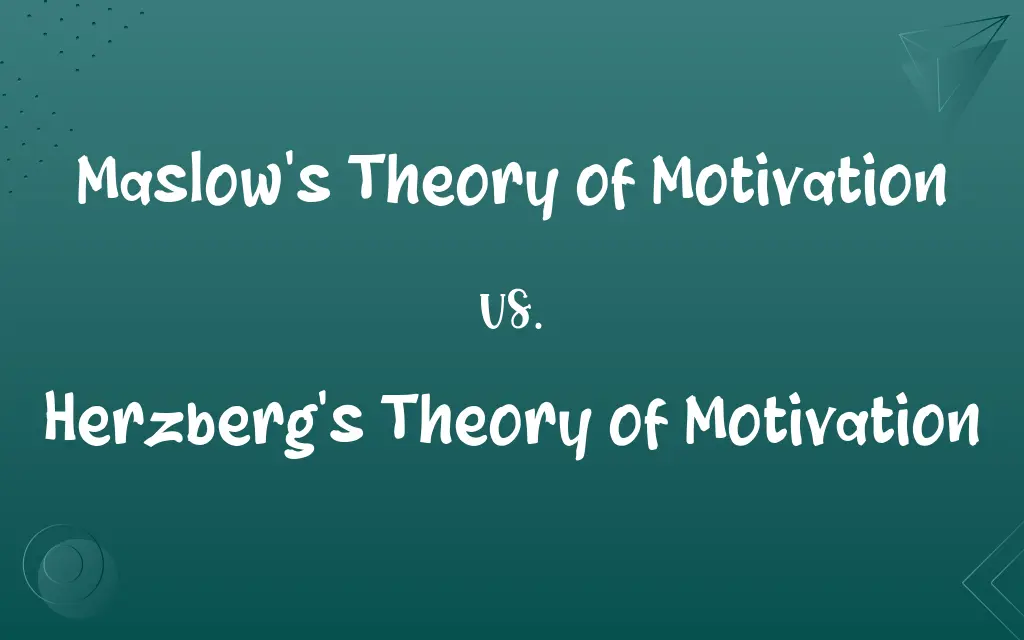Maslow’s Theory of Motivation vs. Herzberg’s Theory of Motivation: Know the Difference

By Shumaila Saeed || Published on January 17, 2024
Maslow's Theory of Motivation suggests a hierarchy of needs drives human motivation, while Herzberg's Theory distinguishes between hygiene factors and motivators in the workplace.

Key Differences
Maslow’s Theory of Motivation, developed by Abraham Maslow, is a psychological theory that proposes a hierarchy of human needs. According to this theory, individuals are motivated to fulfill basic needs before moving on to higher-level needs. The hierarchy is often depicted as a pyramid, with physiological needs at the base, followed by safety, love/belonging, esteem, and self-actualization at the top.
Shumaila Saeed
Jan 17, 2024
Herzberg’s Theory of Motivation, formulated by Frederick Herzberg, is also known as the Two-Factor Theory. This theory asserts that there are certain factors in the workplace that cause job satisfaction, while a separate set of factors cause dissatisfaction. According to Herzberg, hygiene factors (such as salary, work conditions, and company policies) do not lead to higher motivation, though their absence can cause dissatisfaction. Motivators (like achievement, recognition, and the work itself), on the other hand, create job satisfaction.
Shumaila Saeed
Jan 17, 2024
Maslow’s Theory suggests that once a lower level of need is satisfied, it no longer serves as a motivator. The next higher need in the hierarchy becomes the motivating factor. This progressive nature of the model implies that basic needs must be met before higher psychological needs and self-fulfillment desires become motivating factors.
Shumaila Saeed
Jan 17, 2024
In contrast, Herzberg’s Theory posits that job satisfaction and dissatisfaction are not on the same continuum but are instead independent of one another. This means that improving the hygiene factors might reduce dissatisfaction but will not increase satisfaction or motivation. Only motivators can increase job satisfaction, according to Herzberg.
Shumaila Saeed
Jan 17, 2024
Maslow’s Theory is broad and applies to all aspects of human life, reflecting a general perspective on motivation. It is not limited to the workplace but encompasses a wide range of human desires and needs.
Shumaila Saeed
Jan 17, 2024
ADVERTISEMENT
Herzberg’s Theory, however, is specifically focused on motivation in the workplace. It directly addresses job attitudes and is concerned with factors that lead to positive job attitudes and work motivation.
Shumaila Saeed
Jan 17, 2024
A key aspect of Maslow’s Theory is its hierarchical structure, which implies a sequential order of needs. This structure suggests that fulfilling lower-level needs is a prerequisite to pursuing higher-level needs.
Shumaila Saeed
Jan 17, 2024
On the other hand, Herzberg’s Theory does not present a hierarchical or sequential order. It distinguishes between factors that cause satisfaction and dissatisfaction as two separate dimensions, implying that both sets of factors can be present or absent independently.
Shumaila Saeed
Jan 17, 2024
Maslow’s Theory emphasizes the importance of internal needs and personal development as drivers of motivation. It highlights the journey towards self-actualization, considering personal growth as a fundamental human motivator.
Shumaila Saeed
Jan 17, 2024
In Herzberg’s Theory, the emphasis is on external factors such as job conditions, rewards, and recognition, in addition to the nature of the work itself. It underlines the significance of job enrichment and the design of tasks to boost employee motivation.
Shumaila Saeed
Jan 17, 2024
ADVERTISEMENT
Comparison Chart
Theoretical Basis
Hierarchy of human needs
Two-factor model: hygiene factors and motivators
Shumaila Saeed
Jan 17, 2024
Scope
Broad, covering all human needs
Focused specifically on workplace motivation
Shumaila Saeed
Jan 17, 2024
Structure
Hierarchical needs
Independent factors causing satisfaction and dissatisfaction
Shumaila Saeed
Jan 17, 2024
Application
General, not limited to the workplace
Specifically designed for the workplace
Shumaila Saeed
Jan 17, 2024
Emphasis
Internal needs and personal development
Job conditions, rewards, recognition, and nature of the work
Shumaila Saeed
Jan 17, 2024
ADVERTISEMENT
Maslow's Theory of Motivation and Herzberg's Theory of Motivation Definitions
Maslow's Theory of Motivation
The theory emphasizes personal growth and self-actualization as ultimate motivators.
A training program aligning with Maslow’s Theory might offer career development courses to cater to employees' self-actualization needs.
Shumaila Saeed
Jan 06, 2024
Herzberg's Theory of Motivation
Herzberg's Theory differentiates between hygiene factors and motivators in job satisfaction.
According to Herzberg’s Theory, increasing an employee's salary (a hygiene factor) might not enhance job satisfaction as much as offering recognition (a motivator).
Shumaila Saeed
Jan 06, 2024
Maslow's Theory of Motivation
This theory posits that basic needs must be met before pursuing higher psychological needs.
Under Maslow’s Theory, a person must have job security (a safety need) before seeking esteem through career advancement.
Shumaila Saeed
Jan 06, 2024
Herzberg's Theory of Motivation
Hygiene factors do not motivate, but their absence can cause dissatisfaction.
Under Herzberg’s Theory, a company ensures basic employee benefits to prevent dissatisfaction but relies on career advancement opportunities for motivation.
Shumaila Saeed
Jan 06, 2024
Maslow's Theory of Motivation
Maslow’s Theory includes five levels of needs: physiological, safety, love/belonging, esteem, and self-actualization.
An educational program designed based on Maslow’s Theory first ensures students' basic needs are met before focusing on self-esteem and self-actualization.
Shumaila Saeed
Jan 06, 2024
Herzberg's Theory of Motivation
Herzberg emphasized that true motivation comes from the work itself and factors like achievement and recognition.
A firm applying Herzberg’s Theory might focus on task variety and employee recognition programs to boost motivation.
Shumaila Saeed
Jan 06, 2024
Maslow's Theory of Motivation
Maslow’s model is a progressive hierarchy, where fulfilling a lower need propels motivation towards the next level.
In a Maslow-inspired approach, a company might first provide a safe working environment before encouraging team bonding (belonging need).
Shumaila Saeed
Jan 06, 2024
Herzberg's Theory of Motivation
This theory asserts that job satisfaction and dissatisfaction are influenced by different factors.
In Herzberg’s model, improving work conditions might reduce complaints (dissatisfaction) without necessarily increasing motivation.
Shumaila Saeed
Jan 06, 2024
Maslow's Theory of Motivation
Maslow's Theory suggests human motivation is driven by a hierarchy of needs.
A company focusing on employee wellness addresses Maslow’s needs hierarchy by ensuring basic health and safety before promoting personal development.
Shumaila Saeed
Jan 06, 2024
Herzberg's Theory of Motivation
Herzberg’s Theory suggests job enrichment as a key factor for enhancing employee motivation.
A company redesigns jobs to include more challenging tasks, aligning with Herzberg’s Theory to increase employee engagement and satisfaction.
Shumaila Saeed
Jan 06, 2024
Repeatedly Asked Queries
What is the main focus of Maslow’s Theory of Motivation?
It focuses on fulfilling human needs in a hierarchical order, from basic to self-actualization needs.
Shumaila Saeed
Jan 17, 2024
What does Herzberg’s Theory of Motivation primarily address?
It addresses factors that lead to job satisfaction and dissatisfaction in the workplace.
Shumaila Saeed
Jan 17, 2024
How do hygiene factors in Herzberg’s Theory affect motivation?
They don't motivate but their absence can lead to dissatisfaction.
Shumaila Saeed
Jan 17, 2024
How practical is the application of Maslow’s Theory in modern organizations?
While foundational, its hierarchical nature might be too simplistic for the complex dynamics of modern workplaces.
Shumaila Saeed
Jan 17, 2024
Are Maslow’s physiological and safety needs related to Herzberg’s hygiene factors?
Yes, they are similar as both sets of needs/factors are fundamental for avoiding dissatisfaction.
Shumaila Saeed
Jan 17, 2024
Can Maslow’s Theory be applied outside of the workplace?
Yes, it's a broad theory applicable to various aspects of human life, not just work.
Shumaila Saeed
Jan 17, 2024
Are Herzberg’s motivators similar to Maslow’s higher-level needs?
Yes, they are somewhat similar as both involve psychological growth, recognition, and achievement.
Shumaila Saeed
Jan 17, 2024
What motivates individuals according to Maslow’s Theory?
The desire to fulfill needs ranging from basic (like food and safety) to higher needs (like esteem and self-actualization).
Shumaila Saeed
Jan 17, 2024
Is Herzberg’s Theory limited to work-related motivation?
Yes, it specifically deals with factors affecting motivation in the workplace.
Shumaila Saeed
Jan 17, 2024
Is self-actualization in Maslow’s Theory relevant in the workplace?
Yes, it's relevant as it relates to personal growth and fulfilling one's potential, which can be applicable in a career context.
Shumaila Saeed
Jan 17, 2024
Can Maslow’s Theory explain employee motivation in detail?
It provides a general framework but might not address specific workplace motivations in detail.
Shumaila Saeed
Jan 17, 2024
Does Herzberg’s Theory suggest improving hygiene factors to boost motivation?
No, improving hygiene factors can reduce dissatisfaction but not necessarily increase motivation.
Shumaila Saeed
Jan 17, 2024
Can a well-paid job satisfy all levels of Maslow’s hierarchy?
No, while it may satisfy basic needs, higher levels like esteem and self-actualization require more than just financial rewards.
Shumaila Saeed
Jan 17, 2024
Is Maslow’s Theory suitable for individual counseling and coaching?
Yes, it can be used effectively in these areas to address personal development and needs fulfillment.
Shumaila Saeed
Jan 17, 2024
How does Herzberg’s Theory view recognition and achievement?
It views them as motivators that lead to job satisfaction and increased motivation.
Shumaila Saeed
Jan 17, 2024
Can Maslow’s hierarchy be skipped or reordered?
Traditionally, it's seen as a linear progression, but some modern interpretations allow for more flexibility.
Shumaila Saeed
Jan 17, 2024
Does Herzberg’s Theory support job enrichment?
Yes, job enrichment is a key recommendation of Herzberg’s Theory to increase job satisfaction.
Shumaila Saeed
Jan 17, 2024
Does Herzberg’s Theory imply that salary is not a key motivator?
Yes, according to Herzberg, salary is a hygiene factor that can prevent dissatisfaction but is not a primary motivator.
Shumaila Saeed
Jan 17, 2024
Share this page
Link for your blog / website
HTML
Link to share via messenger
About Author
Written by
Shumaila SaeedShumaila Saeed, an expert content creator with 6 years of experience, specializes in distilling complex topics into easily digestible comparisons, shining a light on the nuances that both inform and educate readers with clarity and accuracy.









































































